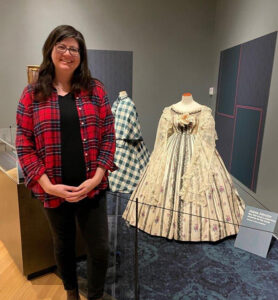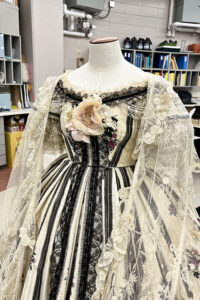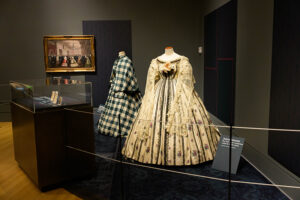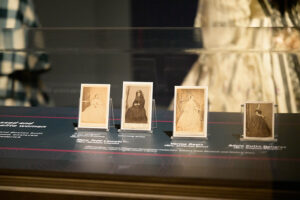Published March 21, 2023
Saying Yes to the Dress
 Meghan Smith, the conservation lab manager for the Indiana State Museum and Historic Sites, grew up wanting to be a filmmaker like Steven Spielberg.
Meghan Smith, the conservation lab manager for the Indiana State Museum and Historic Sites, grew up wanting to be a filmmaker like Steven Spielberg.
“Obviously, my life took a different turn – and I’m not mad about that,” she said.
Right now, in fact, Smith is exceptionally happy because she had a hand in bringing two dresses created for Spielberg’s 2012 movie “Lincoln” to the Indiana State Museum for the new exhibition “Influencing Lincoln, the Pursuit of Black Freedom.”
The story of the dresses starts in 2011, when Smith was working as the costume and textile collections manager at the Chicago History Museum. Joanna Johnston, the costume designer for the “Lincoln” movie, and her team reached out to Smith to research the Lincoln-era fashions that the museum had in its collection.
 Smith helped them re-create a faithful copy of a green-and-white-checked traveling dress by measuring the size of the prints, the buttons and even the waist. That dress is now on display at the state museum, as is a mashup of two different dresses, one floral and one striped, that Johnston found in another collection.
Smith helped them re-create a faithful copy of a green-and-white-checked traveling dress by measuring the size of the prints, the buttons and even the waist. That dress is now on display at the state museum, as is a mashup of two different dresses, one floral and one striped, that Johnston found in another collection.
Johnston’s intention was to get as close as possible to the original designs that designer Elizabeth Keckly had made for Mary Todd Lincoln.
And it worked.
Johnston was nominated for her first Oscar for her work on “Lincoln.”
“Keckly was very stylish,” Smith said. “She knew the trends – she set the trends, in some cases. The traveling dress was interesting because it’s got this huge skirt and you would have worn it with a corset. It’s still very much made for comfort. Mary Todd was going to her not just for eveningwear and fashionable dresses but also for daywear and practical garments because she still wanted to look good. The evening dress is more exaggerated – off the shoulder, very classic 1860s look. Lots of lace, lots of frippery, a big, bold pattern. She was doing all those things.”
 Fast-forward to last summer, when discussions were ongoing about items to include in the Indiana State Museum’s “Influencing Lincoln” exhibit. Chief Curator and Research Officer Susannah Koerber and Curator of Social History Kisha Tandy, also co-curators of this exhibit, mentioned wanting to find some original fashions that Keckly had designed. Smith knew that the Chicago History Museum had an original Keckly dress, “but it doesn’t get out very often because of the potential for damage from light and humidity.”
Fast-forward to last summer, when discussions were ongoing about items to include in the Indiana State Museum’s “Influencing Lincoln” exhibit. Chief Curator and Research Officer Susannah Koerber and Curator of Social History Kisha Tandy, also co-curators of this exhibit, mentioned wanting to find some original fashions that Keckly had designed. Smith knew that the Chicago History Museum had an original Keckly dress, “but it doesn’t get out very often because of the potential for damage from light and humidity.”
But, she told them, “I happen to know they made a replica for the film ‘Lincoln’ that didn’t end up getting used. But Sally Field was fitted in it and took pictures in it.”
The museum got in touch with Spielberg’s Amblin Hearth Archive, which agreed to lend the dresses.

The importance of having the dresses in the exhibition goes well beyond aesthetics. The overarching message of the exhibit is that Black people helped influence President Lincoln’s thinking. Keckly, who was Black, was among Mrs. Lincoln’s closest friends. She had Mrs. Lincoln’s ear and, by extension, the president’s, who was wrestling with the issues of slavery and emancipation.
“It’s emblematic of Elizabeth Keckly’s influence in Mary Todd’s life that she was her modiste – her dressmaker,” Smith said. “They were very close. This was Keckly’s entry point into her life, so this represents that interesting pathway. Especially as a woman, that’s an interesting way to affect change.”
And having the dresses from Spielberg’s archives gives visitors more insight into this important relationship.
“This is a big deal for us,” Smith said. “And it’s really cool for me to come full circle with this project.”









